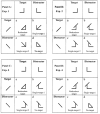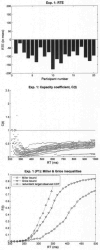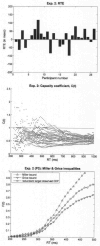Where similarity beats redundancy: the importance of context, higher order similarity, and response assignment
- PMID: 19045985
- PMCID: PMC2597002
- DOI: 10.1037/a0012320
Where similarity beats redundancy: the importance of context, higher order similarity, and response assignment
Erratum in
- J Exp Psychol Hum Percept Perform. 2009 Feb;35(1):169
Abstract
People are especially efficient in processing certain visual stimuli such as human faces or good configurations. It has been suggested that topology and geometry play important roles in configural perception. Visual search is one area in which configurality seems to matter. When either of 2 target features leads to a correct response and the sequence includes trials in which either or both targets are present, the result is a redundant-target paradigm. It is common for such experiments to find faster performance with the double target than with either alone, something that is difficult to explain with ordinary serial models. This redundant-targets study uses figures that can be dissimilar in their topology and geometry and manipulates the stimulus set and the stimulus?response assignments. The authors found that the combination of higher order similarity (e.g., topological) among the features in the stimulus set and response assignment can effectively overpower or facilitate the redundant-target effect, depending on the exact nature of the former characteristics. Several reasonable models of redundant-targets performance are falsified. Parallel models with the potential for channel interactions are supported by the data.
Figures










References
-
- Ashby FG, Townsend JT. Varieties of perceptual independence. Psychological Review. 1986;93:154–179. - PubMed
-
- Chen L. The topological approach to perceptual organization. Visual Cognition. 2005;12:553–637.
-
- Clark HH, Chase WG. On the process of comparing sentences against pictures. Cognitive Psychology. 1972;3:472–517.
-
- Colonius H, Townsend JT. Activation-state representation of models for the redundant-signals effect. In: Marley AAJ, editor. Choice, decision and measurement: Volume in honor of R Duncan Luce. Mahwah, NJ: Erlbaum; 1997. pp. 245–254.

